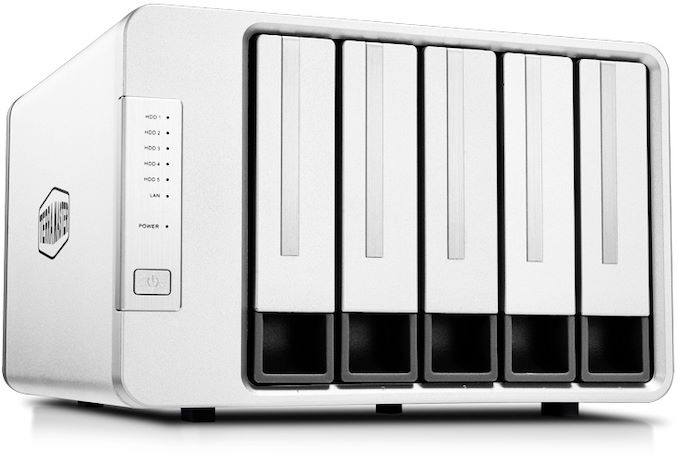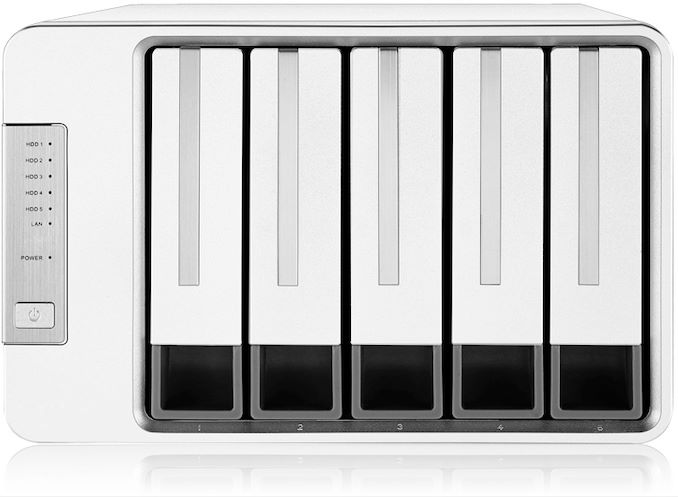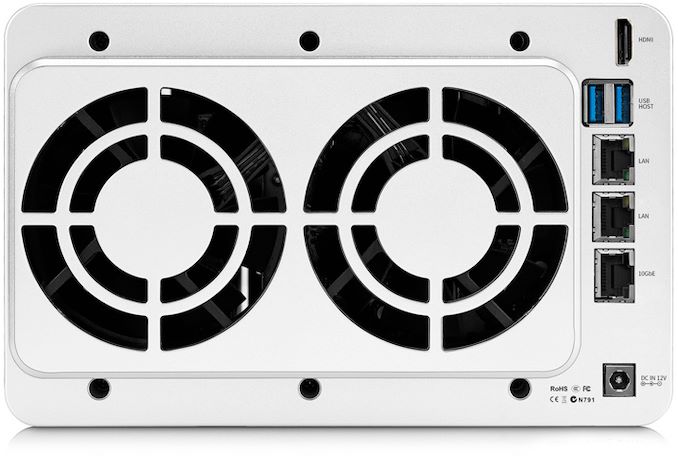CES 2020: TerraMaster Shows Off 5-Bay F5-422 NAS with 10 Gb Ethernet
by Anton Shilov on January 17, 2020 1:00 PM EST- Posted in
- NAS
- Storage
- Trade Shows
- TerraMaster
- CES 2020

TerraMaster unveiled a new five-bay NAS with a 10 GbE connectivity at this year's CES. The F5-422 is based upon Intel Apollo Lake SoC, and runs the company’s TOS 4.1 operating system on top of it, supporting up to 5 3.5-inch drives.
The TerraMaster F5-422 is powered by Intel’s Celeron J3455 quad-core SoC (1.5 GHz – 2.3 GHz) that is paired with 4 GB of memory (expandable to 12 GB). The unit can accommodate five 3.5-inch/2.5-inch hard drives or solid-state drives, which means with today's largest 16 TB HDDs, the NAS can accommodate a total of 80 TB in storage. And, as you'd expect for a modern NAS, the F5-422 supports various RAID modes, including RAID 1, RAID 5, RAID 6, and RAID 10.
Once released, the F5-422 NAS will be one of a handful of prosumer NASes on the market with support for high speed Ethernet, thanks to its one 10 GbE port. As well, the NAS supports two 1 GbE connectors, two USB 3.0 ports, and an HDMI display output. Though it should be noted that despite presence of an HDMI port, the NAS is not designed to work as a media player.
From performance point of view, the NAS is rated to read data at up to 670 MB/s speed as well as write data at up to 650 MB/s when all of its drives operate in RAID 5 mode. Meanwhile, TOS 4.1 OS supports SSD caching to accelerate I/O performance. The NAS can be used by large companies as it supports concurrent access for up to 500 users.
In addition to AES-NI and RAID modes, TerraMaster’s F5-422 with TOS 4.1 supports multiple security layers, including clustered Btrfs file system and snapshots as well as scheduled backups (including an option to back up to the cloud).
TerraMaster will begin selling the F5-422 shortly. Prices will vary with the configuration.
Related Reading:
- QNAP Unveils HS-453DX Silent NAS: Two HDDs, Quad-Core SoC, HDMI 2.0, 10 GbE
- QNAP Announces TS-332X Three-Bay NAS with 10 GbE
- QNAP Launches 16-Bay AMD Ryzen-Based TS-1677X NAS with 10 GbE
- Synology Introduces DiskStation DS1618+ with Intel Denverton
- Next-Gen NAS: An Interview with Alex Wang, CEO of Synology America
- QNAP Launches TS-963X NAS: x86 NAS With 9 Bays & 10 GbE/Multi-Gig Ethernet
Source: TerraMaster












33 Comments
View All Comments
katsetus - Monday, January 20, 2020 - link
Five bays seems like it is meant to be used in RAID10 with an SSD in the fifth bay for caching. But the bays are all the same, in case you don't want to do that, and just use five disks in JBOD. There is nothing wrong with putting a small SSD in a giant drive bay.To me it looks like a pretty decent NAS.
jabber - Tuesday, January 21, 2020 - link
Yeah RAID10 all the way, especially with the netowrk bandwidth this can push. Finally worthwhile.Reflex - Tuesday, January 21, 2020 - link
The reason most NAS's don't show any improvement moving to SSD's is that they are connected to the network with gigabit ethernet, which a HDD can nearly saturate. A SSD will improve in terms of random access and latency, but it can't improve much in terms of total transfer speeds. Even with 10GigE, they are limited still by being on the SATA bus.The upside though is that the need for mass transfer of large files is limited, the vast majority of backups are differential and the few employees who may be intentionally uploading large files (rather than working locally and letting the sync software deal with it in the background) can be handled by simply having a NAS with sufficient M.2 based cache.